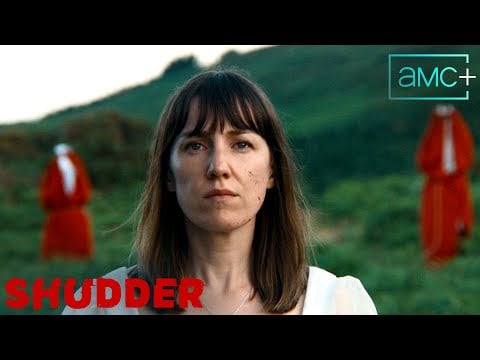Midsommar has become the staple of folk horror, at least in the current age. In a world post-Midsommar, there are pale imitators and bold companion pieces. Fréwaka does not reinvent the subgenre; it is stirring, yet bogs down in the details. Fréwaka translates loosely from Gaelic to mean roots. The film takes a version of this word, meaning something deeply entrenched and tangled, and here, where the story takes it, great leaps. This is a stirring tale of grief and trauma, blending folk horror and genuine suspense; the drawback is that the film becomes a little too obsessed with atmosphere and aesthetic, so we lose the thread along the way.
Set in Ireland, Shoo (Clare Monnelly), reeling from her mother’s recent death, travels to a secluded village to become a caretaker for an aging woman. Peig (Brid Ni Neachtain) is paranoid and agoraphobic, and fears her neighbors. She also lives in terror of Na Sídhe — a supernatural force in Gaelic folklore, invisible to the naked eye. They are destructive and merciless creatures, who she claims abducted her decades ago. Her fear and neurosis begin to rub off on Shoo. There are shared suspicions and superstitions that force Shoo to confront her past terrors.
For its strengths, Fréwaka is like a thick Irish stew. It’s rich in Gaelic history and tradition, allowing the movie to ooze atmosphere and a foreboding presence. As a silent piece, the film is quite haunting. The remnants of fog, the creepy whispers, and the unsettling vestige of a village scream: horror. The film is like a ghost story, told around the campfire, with whispers of rituals and dabbles in the occult. It is more than a feeling than an actual story; using Gaelic from many characters helps create a sense of distance and almost imbalance that furthers the whimsical and supernatural elements.
Shoo’s journey in the film is preceded by the tragic death of her estranged mother. Her decision to become a caretaker for Peig serves as a way of escaping the tragedy of her mother. This is ultimately the film’s narrative; Peig’s scars affect Shoo as she attempts to do her job and come to terms with her mother’s passing. The film arrives, making a unique connection between the two while unpacking Shoo’s psychological damage. The problem is that the film becomes too focused on its aesthetic, and the story, which takes a long and winding road, feels rushed at the bitter end.
There is a lot in this film, and it is far from an empty vessel. Shoo and her fiancée, Mila (Aleksandra Bystrzhitskaya) are apart. She is pregnant, furthering Shoo’s own guilt and internal conflict. There is the idea for Shoo that if it is not one thing, it’s her mother. When the story examines the fraught relationship between mother and daughter vis-à-vis the caretaking relationship with Peig, there are shots of brilliance. The film works its scares and terror through symbolism and iconography, but its real strength is examining the terrors within us. The movie exposes trauma and the nature of old wounds refusing to heal.

There is a revelation that both Peig and later Shoo are victims of the Catholic Church. This allows this film to have a religious subtext, furthering the supernatural elements and the plain old trauma. Fréwaka establishes a balance between the events in the movie being simply true and the result of latent paranoia. It never commits in either direction, allowing the audience to digest the totality. Is this the occult, or is it a figure of shared delusions and the drip, drip of paranoia?
The effect might be better felt if this were a strictly silent film. The imagery is stirring, and the incorporation of the Irish locale allows this to exist as if it were a fairy tale. The images are gripping and, at points, entirely arresting. Director Aislinn Clarke does not shy away from giving us an experience. There are elements of Midsommar, The Wicker Man, and even shades of The Witch. However, the difference between those three films was that there were stronger narratives that complemented the stirring imagery.
Fréwaka engrosses us with a riveting palette yet engorges us too much, preventing the story from taking hold. The performances are layered, but the gradual build-up to the story’s end is long-winded and anticlimactic. The film stirs like the flickering flames on a campfire, but once the embers die out, so does our interest in the story.
Fréwaka is currently available to stream on Shudder.




